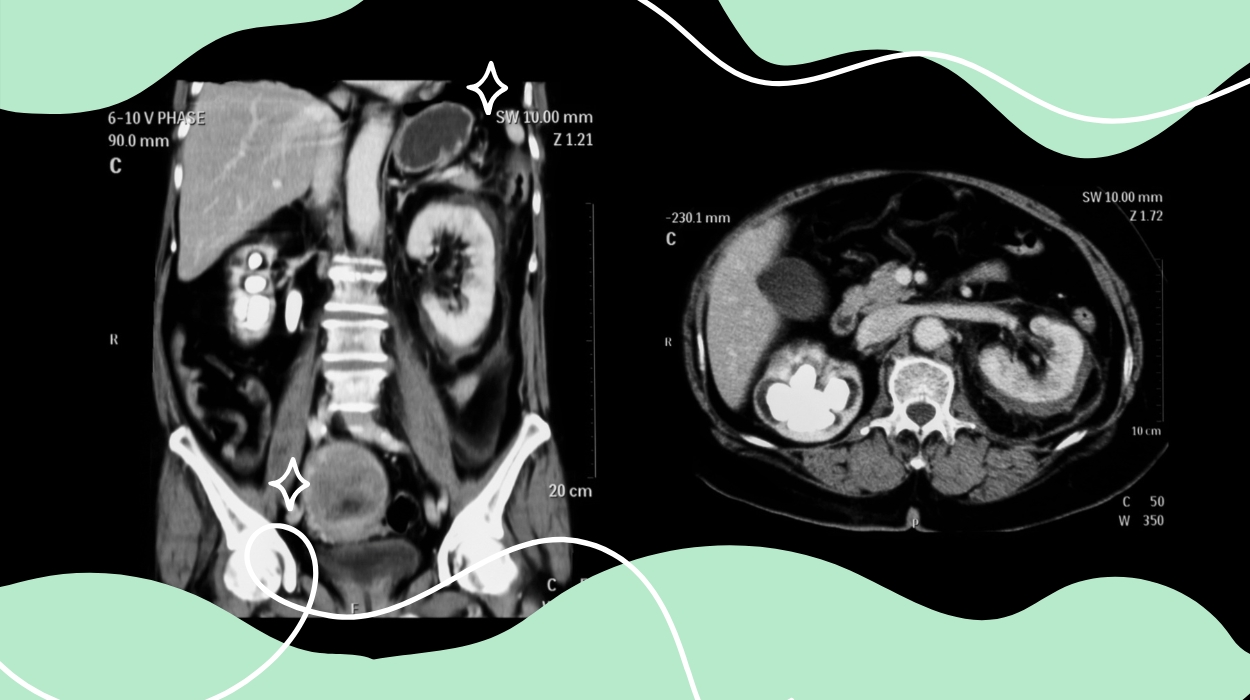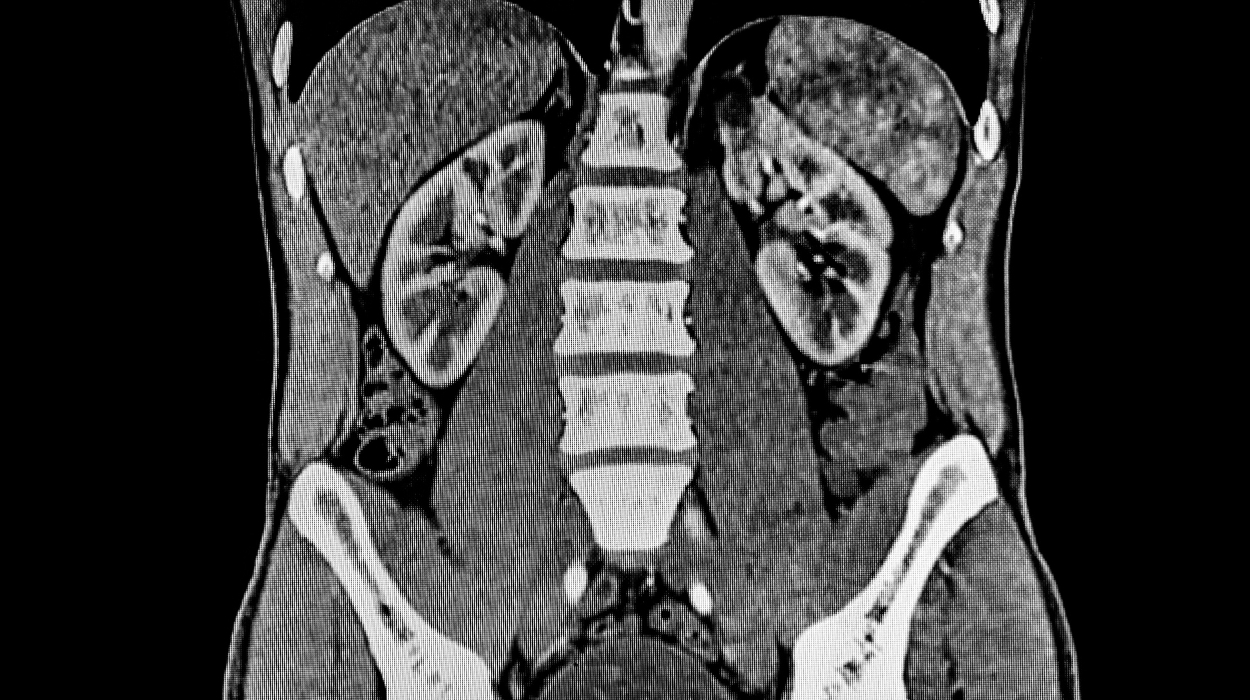 Evidence Based
Evidence Based
Evidence Based
This article is objectively based on relevant scientific literature, written by experienced medical writers, and fact-checked by a team of degreed medical experts.
Our team of registered dietitian nutritionists and licensed medical professionals seek to remain objective and unbiased while preserving the integrity of any scientific debate.
The articles contain evidence-based references from approved scientific sites. The numbers* in parentheses (*1,2,3) will take you to clickable links to our reputable sources.
Kidney Stone CT Scan: What Is It & What To Expect?

Kidney stones are an excruciatingly painful experience, affecting about one in ten[1] people in the United States with half that the pain is due to getting another within five years. Most will have their first diagnosis in an emergency department after presenting with flank pain, nausea, or bloody urine.
Diagnosing a kidney stone requires an image to confirm the presence of a stone and remove doubts of alternative causes such as an injury or cancer. Among the various imaging techniques available, the kidney stone computerized tomography (CT) scan has emerged as a powerful tool for accurately identifying and assessing these mineral deposits.
In this article, we will discuss the role of a CT scan in diagnosing kidney stones. We will examine the advantages and disadvantages for using imaging tests and what to expect from them. Finally, we will provide guidance on what may happen next in the treatment process for getting rid of kidney stones.
Kidney Stone CT Scan
- Computed Tomography[2] scans are medical imaging tests with radiation that take many images from different depths and angles inside the body resulting in three dimensional pictures that allow for the visualization of organs, bones, and tissues.
- CT scans are used to visually locate kidney stones, determine stone size and density, and visualize any damage or other possible problems.
- Similar to an MRI, CT scans are done lying down, last about 10 to 20 minutes, and they don’t cause any feelings or sensations.
CT Scan For Kidney Stone: Its Role In Diagnosis
The first goal of an imaging test[3] for kidney stones is diagnosis. Then the stone size and location are determined to predict if the stone will pass without surgical intervention. Imaging will not predict the severity of symptoms because there are too many contributing factors such as obstruction of the ureter and tissue damage from movement. When asymptomatic, a new image may be needed to locate or confirm passage of a kidney stone.
Imaging technologies that are widely available include radiography (X-ray), magnetic resonance imaging (MRI), ultrasonography (ultrasound), and computed tomography. Let’s examine the advantages and disadvantages specifically for CT scans.
Pros
- Almost all stones can be seen on a CT scan.
- The detailed anatomical images enable evaluation of potential other causes for symptoms.
- Sometimes, a CT scan may check the density of the stone. Knowing the density indicates the stone’s composition and predicts its responsiveness to treatment with shockwave lithotripsy.
- The accuracy of CT scans is very high, particularly for larger patients with a BMI greater than 30.
- CT scans are fairly inexpensive being double the cost of an ultrasound, but one third the cost of an MRI.
Cons
- Stones caused by protease-inhibitor medications in the urine cannot be detected.
- Not recommended for people under 14 years.
- Not recommended in pregnancy.
- A standard CT provides a fair amount of radiation exposure. Exposure accumulates over your lifetime and becomes an issue for recurrent users. Cancerous malignancies have been documented after a dose equal to ten CT scans.
Alternative Imaging Tests
Low-dose radiation CT scans use about one third the radiation. Although stones are still easy to be seen and located in the image, the image quality and analysis of density are worse. It is more difficult to see non-stone-related issues and stones less than 3 mm. They can’t be used if your BMI is over 30.
Ultrasounds use sound waves to image the body and are very low cost. They may be just as effective in locating a stone as CT scans despite having poorer image quality. It is easy to miss stones less than 3 mm. Some locations are difficult to reach with the ultrasound and this gets worse as BMI increases. This is an excellent alternative to eliminate or reduce radiation exposure.
Radiography of the kidney, ureter, and bladder is a lower radiation alternative to CT scans with about 7% of the dose. It costs the least of all imaging tests too. It provides an image similar to CT scans, but it only creates images that are 2D and it doesn’t let you see around objects in the body.
MRI scans use a magnetic field to scan the body with no exposure to radiation. It has similar detailed images compared to CT scans when used for detecting kidney stones. The drawback is that they may take longer and cost a lot more.
What Is A CT Scan?

Computed tomography[4] scans use ionizing radiation to take many internal images very quickly. Computer technology combines them into a 3D image where you can see bones and soft tissues such as blood vessels and organs. They are used in many areas of medicine to detect tumors, infections, blood clots, bleeding, and much more. Sometimes, CT scans are done with a contrast dye to help with imaging, but this is not necessary for a CT scan of kidney stone.
CT Scan Kidney Stone: What To Expect
Preparation
Since most kidney stones are discovered in urgent care or an emergency department, you may not have much advance warning for preparation[5] before having a CT scan. If given an appointment, you will be provided instructions to follow. When inside the examination room, you are permitted to ask any questions.
Loose, comfortable clothing can be worn or a hospital gown may be provided to you. You will be asked to remove anything metal such as jewelry because it can interfere with the scan. You should be provided with a safe location to keep your belongings.
Procedure
Follow the instructions from the radiographers. You will often lie on your back on a bed that passes you into the CT scanner. The machine doesn’t surround your whole body, unlike an MRI, and claustrophobia shouldn’t be an issue.
During the scan, the radiographer may ask you to breathe in, breathe out, or hold your breath. They are trying to prevent movements and maintain image quality. The process will take about 10 to 20 minutes.
Post Procedure
You will be permitted to go home with no limitations on diet, driving, or working as a result of the test. Since kidney stones do not require contrast dye for the imaging test you should not have any more concerns in the hospital.
Your scan results take time to be processed by a computer, provided to a radiologist for analysis, and reported to your referring health care professional. This usually takes a few days or weeks.
The Next Steps
Follow the instructions your doctor provides. It should include any dietary restrictions, how much water you should drink a day, medications, and straining your urine to catch the stone if it passes. You may or may not receive counseling about over the counter supplements such as apple cider vinegar or herbal teas to help pass stones. Check with your pharmacist or doctors to ensure they are safe to use with your medications.
Scan results of the stone will guide the doctor’s recommendation for treatment[6], but you may be required to do additional blood or urine tests before treatment is decided. In addition, depending on where the stone is and how big and dense it is, the doctor will consider treatment options for natural passing, shockwave therapy, or surgery.
Conclusion
CT scans are a common and useful option to diagnose kidney stones. A urine sample is not enough for diagnosis, so an imagining test is needed for confirmation of kidney stones and to and eliminate the possibility of other diagnoses. Among the available imaging tests, CT scans provide detailed 3D images that accurately locate and measure kidney stones to assist in making informed decisions for treatment.
Understanding what to expect during a kidney stone CT scan, including the preparation, procedure, and post-scan care, can help you approach the experience with confidence. While you wait for results from your doctor, follow the recommendations they provide and learn as much as you can about how your diet can affect formation and passing of stones. Get started by reading our review for the best apple cider vinegar gummies.
Ultimately, the results of the CT scan will guide your treatment options and you should approach them with an open mind. Kidney stones are dangerous if they don’t pass and are left untreated for many months. Talk with your health care provider to decide the best course of action for you.
Frequently Asked Questions
A 3D image generated by a CT scan will not be bothered by the presence of water in the stomach or intestines. However, your doctor may have other reasons to restrict your diet and liquids for other tests and treatments.
The scan is not painful and should not give you any sensations. The scanner is outside the body and may or may not move around the body for a moment. While a contrast dye may be used in a CT scan, it is not required for suspected kidney stones and there is nothing invasive involved.
Once you are in position for a CT scan, the process should be done within seconds. It takes longer if the scan needs to be repeated. For example, movement during the scan will provide a poor image, prompting a rescan.
+ 6 sources
Health Canal avoids using tertiary references. We have strict sourcing guidelines and rely on peer-reviewed studies, academic researches from medical associations and institutions. To ensure the accuracy of articles in Health Canal, you can read more about the editorial process here
- Siener, R. (2021). Nutrition and Kidney Stone Disease. [online] 13(6), pp.1917–1917. doi:https://doi.org/10.3390/nu13061917.
- Anon, (2023). Computed Tomography (CT) Scans . [online] Available at: https://www.cdc.gov/nceh/radiation/ct_scans.html.
- Brisbane, W., Bailey, M.R. and Sorensen, M.D. (2016). An overview of kidney stone imaging techniques. [online] 13(11), pp.654–662. doi:https://doi.org/10.1038/nrurol.2016.154.
- Center (2023). Computed Tomography (CT). [online] U.S. Food and Drug Administration. Available at: https://www.fda.gov/radiation-emitting-products/medical-x-ray-imaging/computed-tomography-ct.
- Medlineplus.gov. (2021). Abdominal CT scan: MedlinePlus Medical Encyclopedia. [online] Available at: https://medlineplus.gov/ency/article/003789.htm.
- Khan, S.R., Pearle, M.S., Robertson, W., Gambaro, G., Canales, B.K., Steeve Doizi, Olivier Traxer and Hans-Göran Tiselius (2016). Kidney stones. [online] 2(1). doi:https://doi.org/10.1038/nrdp.2016.8.



